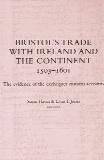Bristol’s trade with Ireland and the Continent 1503–1601: the evidence of the exchequer customs accounts
Published in Book Reviews, Early Modern History (1500–1700), Early Modern History Social Perspectives, Issue 1 (Jan/Feb 2010), Reviews, Volume 18Susan Flavin and Evan T. Jones (eds)
(Four Courts Press, E65)
ISBN 9781846821820
 This 1,094-page tome reproduces the details of the cargoes of ships plying between Ireland and the Continent in and out of Bristol for 100 years. Two factors make the work remarkable: the first is that the records survive and the second is that they have been reproduced in an easily accessed format. The records were originally written in medieval Latin on parchment, making a certain amount of clarification appropriate. Ireland’s Tudor records were lost in the Four Courts explosion of 1922 during the civil war. Some aspects of the trade can be reconstructed from the Bristol records.
This 1,094-page tome reproduces the details of the cargoes of ships plying between Ireland and the Continent in and out of Bristol for 100 years. Two factors make the work remarkable: the first is that the records survive and the second is that they have been reproduced in an easily accessed format. The records were originally written in medieval Latin on parchment, making a certain amount of clarification appropriate. Ireland’s Tudor records were lost in the Four Courts explosion of 1922 during the civil war. Some aspects of the trade can be reconstructed from the Bristol records.
The bulk of the Irish trade was with Waterford, Cork, Youghal, Dungarvan, Wexford, Kinsale and New Ross. The Dublin–England trade was predominantly with Chester, then Hoylake and ultimately Liverpool, as the sands of the River Dee silted the earlier ports. There is a tantalising mention that a Chester port book exists for 1588/9. Obviously, this would be source material for a similar study at some time in the future and yield much Dublin information.
The trade itself was divided into two distinct categories. Wine was imported into Bristol from the Iberian Peninsula to supply the great wine merchants—the predecessors of Hardy’s. Skins, hides and fish came from Ireland. The absence of wine transhipment to Ireland implies that the Irish ports had their own independent wine trade with the Continent. The exports tended to be more sophisticated. Hops feature prominently, along with knives, iron, playing cards, fabric, cloth and seeds. This shows the more industrial character of Bristol compared with the south of Ireland.
Merchants in Kilkenny, Cashel, Wexford, New Ross and Clonmel, for whom the goods are destined, are recorded. This gives information on trade to the towns involved. Some estimate of the importance of the town can be deduced from the relative size of the cargoes consigned to each place. The early brewing industry in Kilkenny and Waterford is indicated by the imports of hops. This reveals that preserved ale (beer) was being produced and not just short-shelf-life table ale.
Bristol was a centre for lead-processing until twenty years ago, and in 1601 we find cargoes of lead sent by John Hopkins of Bristol to Cork. Just one example of the hundreds is the information recorded on the sailing of the Katherin of Wexford, eight tons burden, Nicholas Haie master, to Wexford, 29 March 1576. She carried a brass pan weighing 60lbs, possibly for a brewery, 120lbs brass pots and pans, iron, pitch, hops, pewter, hemp, and three-dozen black soap. The merchant was Nicholas Haye of Wexford and it is likely that the captain was at least related to the merchant, allowing for variation in the spelling of the name. This will caution the computer-user, as a search will not connect the two. One arrival recorded on 20 July 1543 is the Michaell of Waterford, Robert Fitzjohn master: Richard Donnell, merchant, had consigned sheepskins, lambskins, fox skins and check cloth. But a further thirteen merchants have almost identical goods aboard. This information must be a worthwhile list of the skinners working in Waterford at the time. The quantity of check cloth between the fourteen consignors is described as 60 hundredweight and an additional 2,300 yards. This shows a considerable textile industry, probably based on cottage weavers.
It is remarkable to find ship-owners’ names like Stafford and merchants like Butler mentioned so early, as these names are prominent in commerce to the present day. Luckily, the data are also available in electronic format (Bristol University ROSE project), enabling scholars to carry out their own numerical analysis on the raw data. This makes the work useful to anyone interested in trade during the period examined. It will shed considerable light on Waterford trade. This is a source of data, not bedtime reading, but will stimulate much further research into early trade and shipping. It is a valuable piece of work and indicates the treasure trove yet to emerge from archives. One wonders whether electronic archives will ever reach the same level of detail or if freedom of trade has obliterated this type of customs information. I have no doubt that this meticulous work will kick-start several trade and shipping historical studies among serious maritime historians as well as local historical study groups. For instance, ships are named as well as their masters, so there is insight into ship-owning of the period as well. Indeed, it would be possible to assemble a list of the Waterford coasting fleet of the period as a separate exercise. This work will provide the basis for many a thesis or historical society article on very early recorded trade. The book itself is competently produced by Four Courts and printed in England; the binding is robust, essential for the number of pages. The dust-jacket design is elegantly based on an image of the records themselves. HI
Edward Bourke is a maritime historian with a special interest in industrial history and Irish shipwrecks.
















